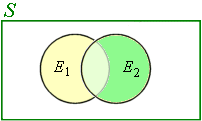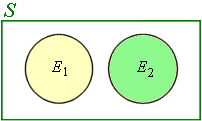Mutually Exclusive Events
Two or more events are said to be mutually exclusive if the occurrence of any one of them means the others will not occur (That is, we cannot have 2 or more such events occurring at the same time).
For example, if we throw a 6-sided die, the events "4" and "5" are mutually exclusive. We cannot get both 4 and 5 at the same time when we throw one die.
If E1 and E2 are mutually exclusive events, then E1 and E2 will not happen together. So the probabality of the 2 events will be zero:
P(E1 and E2) = 0.
Now, suppose "E1 or E2" denotes the event that "either E1 or E2 both occur", then
(a) If E1 and E2 are not mutually exclusive events:
P(E1 or E2) = P(E1) + P(E2) − P(E1 and E2)
We can also write:
P(E1 ∪ E2) = P(E1) + P(E2) − P(E1 ∩ E2)
A diagram for this situation is as follows. We see that there is some overlap between the events E1 and E2. The probability of that overlap portion is P(E1 ∩ E2).
An example for non-mutually exclusive events could be:
E1 = students in the swimming team
E2 = students in the debating team
In this case, the yellow area represents students in the swimming team only, and the darker green area represents students in the debating team only. The light green overlap area represents the students in both the swimming team and the debating team.
(b) If E1 and E2 are mutually exclusive events:
P(E1 or E2) = P(E1) + P(E2)
Our diagram for mutually exclusive events shows that there is no overlap:
An example of mutually exclusive events could be:
E1 = male students
E2 = female students
There is no overlap. [Of course, gender is not a simple issue as in fact, some overlap does occur. Don't read too much into it — this is just an example.]
In this case, the intersection E1 ∩ E2 is empty, leading to the conclusion:
P(E1 ∩ E2) = 0
This explains why, for the mutually exclusive case,
P(E1 or E2) = P(E1) + P(E2)
Example 1
It is known that the probability of obtaining zero defectives in a sample of items is whilst the probability of obtaining defective item in the sample is . What is the probability of
(a) obtaining not more than defective item in a sample?
(b) obtaining more than defective items in a sample?
ANSWER
"Obtaining not more than one" means we choose either or defective.
Let event E1 be "obtaining zero defectives" and E2 be "obtaining defective item".
(a) Events E1 and E2 are mutually exclusive, so
P(E1 or E2) = P(E1) + P(E2) = 0.34 + 0.46 = 0.8
(b)
Example 2
The probability that a student passes Mathematics is and the probability that he passes English is . If the probability that he will pass at least one subject is , what is the probability that he will pass both subjects?
(We assume it is based on probability only.)
ANSWER
- Pass math only
- Pass English only
- Pass both math and English
P(E1 or E2) = P(E1) + P(E2) − P(E1 and E2)So



No comments:
Post a Comment